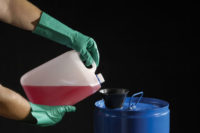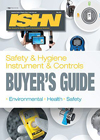
Hazmat emergencies can happen anywhere from the warehouse to the laboratory to industrial sites and the transit system — from the highways to the railroads. The U.S. Department of Transportation reports that 2008 saw 16,877 incidents with hazardous materials in transport. Some 14,760 of those were on the highways, with most requiring the help of first responders to decontaminate the site.
Hazardous materials typically possess at least one of four characteristics — ignitability, corrosiveness, reactivity or toxicity. In every case, personal protection equipment (PPE) gloves are a critical element in an overall protective ensemble.
Hazmat zones
When Hazmat emergencies do occur, Homeland Security follows OSHA HAZWOPER Guidelines. They require that the emergency hazardous materials area be divided into as many different zones as needed to:
- Reduce accidental spread of contaminants
- Reduce the number of personnel authorized in the high-risk areas
- Delineate required levels of personal protection to be worn
- Implement emergency evacuation routes.
Hot Zone gloves
Different chemicals have differing Hot Zones depending on the toxicity and flammability of the chemical. First Responders in the Hot Zones require Level A, fully encapsulating suit ensembles with Self-Contained Breathing Apparatus (SCBA). Most First Responders must wear a Level A suit that includes Butyl gloves and Silver Shield laminate gloves. Because Butyl/Butyl II rubber provides superior resistance to highly corrosive acids and handles ketones and esters well, it provides the ultimate combination of protection and dexterity and is frequently recommended for hand protection in hot zones. This synthetic rubber also provides the highest permeation resistance to nerve gases, such as Sarin or mustard gasses, and water vapors.
Warm Zone PPE
The warm zone is the circular area around the Hot Zone for decontamination. If decontamination is not performed onsite, a hospital ER may become the warm zone. This turn of events may pose significant risk if the hospital becomes contaminated. The first receivers may then be the hospital personnel.
The National Fire Protection Association (NFPA) 1992 Standard on Liquid Splash-Protective Ensembles and Clothing for Hazardous Materials Emergencies, 2005 Edition, is designed to set the minimum protection requirements for PPE for persons involved in the warm zone — or second tier — decontamination areas where Level B, C and D protection is needed. This standard establishes the requirements for chemical liquid splash protection when the chemical vapors are no longer a hazard. The liquid splash-protective ensembles are intended for situations in which the primary form of chemical exposure is short-term intermittent contact with liquid chemicals that do not produce skin-toxic or carcinogenic vapors.
The primary purpose of NFPA 1992 is to establish requirements for clothing that keeps liquids from contacting the wearer’s skin. The standard requires that gloves must meet minimum requirements for chemical, cut and puncture resistance; cold weather performance; and dexterity. Compliance to this standard means that the ensemble element is designed for all levels of HazMat response with the exception of the actual Hot Zone.
Hazmat occurrences
If you look at the Agency for Toxic Substance and Disease Registry (ATSDR) branch of the Centers for Disease Control, you will find that the most often transported, stored and spilled chemicals in the United States include fuels and acids and caustics that have resulted in a hazmat incident.
- Fuels: Nitrile gloves are the best choice in hand protection when dealing with fuels from gasoline to kerosene to diesel to jet fuel. Gloves made from a special nitrile (NBR) compound with a casehardened finish provides excellent protection against abrasion, puncture, cut and snag and resistance to a broad range of solvents and other chemicals. This entire family of gloves is certified to the NFPA 1992 standard as part of a protection ensemble designed for First Receivers performing decontamination of rescued victims or of First Responders.
- Acids and caustics: For this major group of stored, transported and spilled chemicals, neoprene gloves provide the best protection. Neoprene gloves would be part of a protection ensemble for First Receivers in the event of an acid or caustic spill.
Evolving hand protection
With hand protection such an integral part of protection for HazMat emergency workers, the industrial glove industry invests in researching and developing better hand protection options. The dozens of choice of nitrile, neoprene and butyl gloves available today represent the long distance this area of PPE has come from the days when the only choices were rubber gloves or rubber gloves.




